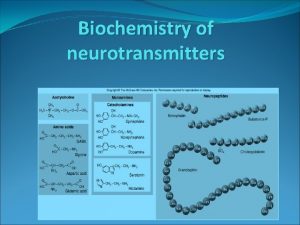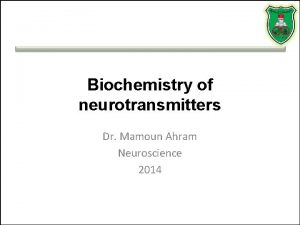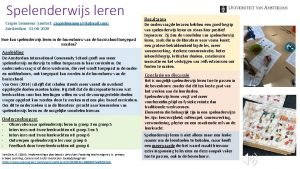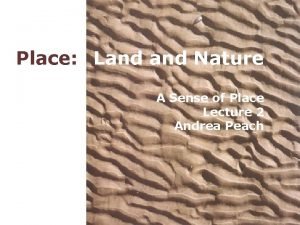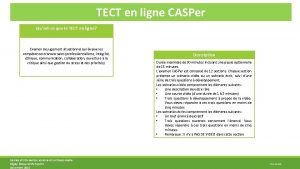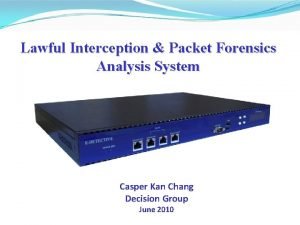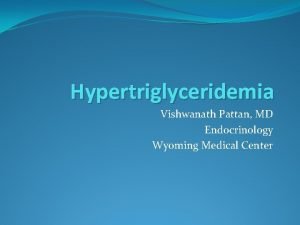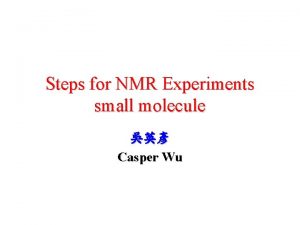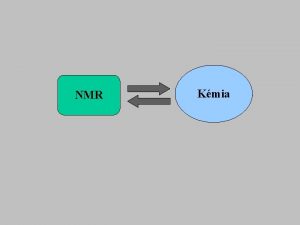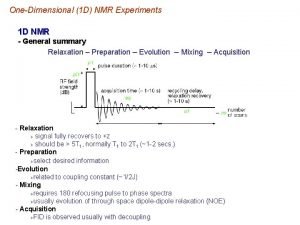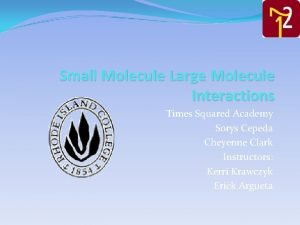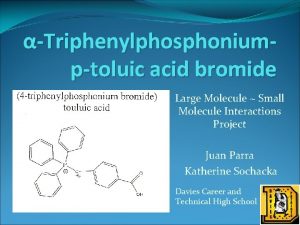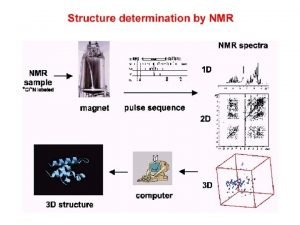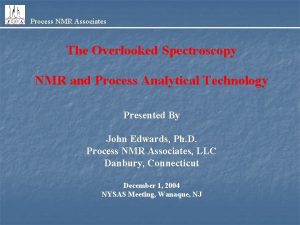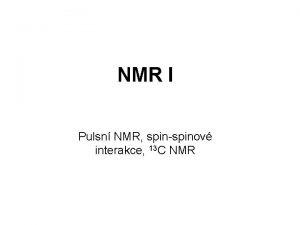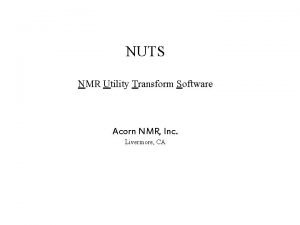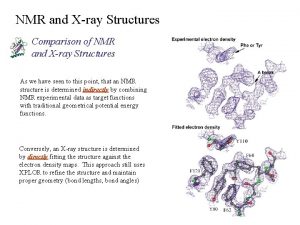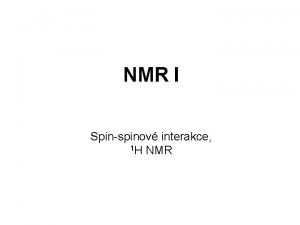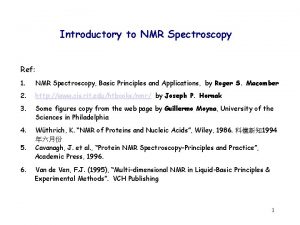Steps for NMR Experiments small molecule Casper Wu














































- Slides: 46

Steps for NMR Experiments small molecule 吳英彥 Casper Wu

OUTLINE 1. 樣品配製 2. 儀器選擇 3. NMR探頭選擇 4. 勻場 5. 1 D 1 H NMR 6. 1 D 13 C NMR 7. 2 D homonuclear NMR 8. 2 D heteronuclear NMR




2. 2 儀器選擇(靈敏度) For 1 H: = 26753 (s-1 Gauss-1) = 2. 6753 (s-1 Tesla-1) (1 Tesla = 104 Gauss) when Bo = 4. 69 T E = h = ( h. Bo)/2 = Bo/2 = 2 108 (s-1) = 200 MHz

2. 3 儀器選擇(靈敏度) Boltzmann equation: N /N = exp(- E/k. T) = exp[( h. Bo)/(2 k. T)] when Bo = 4. 69 T (200 MHz) N /N = 0. 999967 i. e. N = 106 N = 1000033 when Bo = 9. 38 T (400 MHz) N = 106 N = 1000066 field 2 sensitively 2

2. 4 儀器選擇(鑑別度) 600 MHz 500 MHz n-butyl acetate 400 MHz 300 MHz ppm Hz

2. 5 儀器選擇(鑑別度) 500 MHz 400 MHz uridine 300 MHz

3. 1 NMR探頭選擇 Inverse 1 H/2 D X gradient and 1 H sensitivity 50% Observe X 1 H/2 D gradient

3. 2 NMR探頭選擇 Fixed-channel probe Ø SEL: 1 H selective Ø DUL: 13 C and 1 H (inner 13 C, outer 1 H) Ø SEI: selective inverse (inner 1 H, outer X) Ø TXO: triple resonance observe Ø TXI: triple resonance inverse Ø QXI: quattro resonance inverce

3. 3 NMR探頭選擇 Broad-band probe Ø BBO: broad band observe Ø BBI: broad band inverse Ø TBO: tripe resonance broad band observe Ø TBI: tripe resonance broad band inverse Ø QNP: quattro nucleus probe (1 H/13 C/19 F/31 P, 1 H/13 C/15 N/31 P)


3. 5 NMR探頭選擇 ns = 100 exp. time = 11 min NS = 20000 exp. time = 14 hrs 3 mg sample

3. 6 NMR探頭選擇 Gradient (磁場梯度) Z-GRAD: z gradient XYZ-G: x, y, z gradient Ø 節省 5 倍以上的實驗時間 Ø 執行自動化的勻場動作 tuning與matching數值 gradient 接頭 tuning matching BBO z-grad


4. 1 (Shim)

4. 2 氘鎖定 (Deuterium Lock) 勻場(Shim) B 0 = 0 CDCl 3 B 0 0 h (CDCl 3) digital & shaped pulse deuterium lock Better shimming

4. 3 勻場(Shim) Z Z 3, Z 5 -Z 2, -Z 4 Z 2, Z 4

4. 4 勻場(Shim) Z 4 Z 2 and Z 4

5. 1 1 H NMR The number of signals shows how many different kinds of protons are present. The location of the signals shows how shielded or deshielded the proton is. The intensity of the signal shows the number of protons of that type. Signal splitting shows the number of protons on adjacent atoms.

5. 2 Solvent Suppression 提高濃度較稀或高含水量之樣品的靈敏度 H 2 O suppression 25 mg uridine in D 2 O H 2 O

5. 4. 1 1 D Selective Excitation 凸顯目標、簡化問題、減少實驗時間 1 D selective TOCSY 9 7 8 12 11 9 10 8 7 4 5 6 3 12 -ionone 2 1

5. 4. 2 1 D Selective Excitation COSY, TOCSY, NOESY, ROESY Cyclosporine

5. 4. 3 1 D Selective Excitation 1 D selective TOCSY

5. 4. 4 1 D Selective Excitation 1 D selective NOESY

6. 1 13 C NMR 12 C has no magnetic spin. 13 C has a magnetic spin, but is only 1. 1% of the carbon in a sample. The gyromagnetic ratio of 13 C is one-fourth of that of 1 H. Signals are weak, getting lost in noise.

6. 2. 1 Spin-Spin Splitting It is unlikely that a 13 C would be adjacent to another 13 C, so splitting by carbon is negligible. 13 C will magnetically couple with attached protons and adjacent protons. These complex splitting patterns are difficult to interpret.

6. 2. 2 Spin-Spin Splitting 54 6 13 C{1 H} NMR (1 H decoupling) 2 1 3 4 5 3 2 1 6 ethylbenzene 54 2 1 6 3

6. 3. 1 DEPT Distortionless Enhancement by Polarization Transfer CH 3 CH 2 CH 45 CH 90 135 CH + + + CH 2 + - CH 3 + +

6. 3. 2 DEPT 區分碳的級數 4 5 3 2 1 6 ethylbenzene 5 4 6 3 2 s 1

7. 1. 1 同核J-resolved (獲得偶合常數) X M X A 2, 3 -dibromopropionic acid M A

7. 1. 2 異核J-resolved (獲得偶合常數) 4 2 11 9 10 4 8 7 5 6 3 12 -ionone 2 1 3 56 11 9 7 10 12 8 1

7. 2. 2 COSY (獲得 3 J偶合關係) 3 3 1 2 5 4 6 n-butyl acetate 3 1 6 4 5

7. 2. 2 COSY 90 (獲得 3 J偶合關係) X M X A 2, 3 -dibromopropionic acid M A

7. 2. 3 COSY 45 (獲得 3 J與2 J偶合關係) M A X M X a A 2, 3 -dibromopropionic acid (a)vicinal spin-spin coupling (3 J) (b)geminal spin-spin coupling (2 J) a b

7. 3 TOCSY (獲得所有J-偶合關係) 3 3 1 2 5 4 6 n-butyl acetate 3 1 6 4 5

7. 4. 1 NOESY (獲得分子於空間中之關係) 12 1 (<5Å) 7 8 9 11 9 10 8 7 4 5 6 3 2 1 12 -ionone 9 8 11


7. 5 INADEQUATE (獲得 1 JC-C之關係) 2 5 6 4 3 1 2 3 Sucrose 5 4 6 1 5 34352 4 61 6

8. 1. 1 HMQC (獲得 1 JH-X之關係) (X = 13 C, > 0) 3 6 5 1 4 3 3 1 2 5 4 6 n-butyl acetate 2 1 6 4 5

8. 1. 2 HMQC (獲得 1 JH-X之關係) 3 1 2 9 6 3 7 4 8 5 7 9 6 uridine 8 5 2 3 5 2 6 7 99 8

8. 2 HSQC (獲得 1 JH-X之關係) (X = 15 N, < 0) 3 6 5 1 4 3 3 1 2 5 4 6 n-butyl acetate 2 1 6 4 5

8. 3. 1 HMBC (獲得n. JH-X, n 2之關係) 3 6 5 1 4 3 3 1 2 5 4 6 n-butyl acetate 2 1 6 4 5

8. 3. 2 HMBC satellite 1 3 1 2 5 4 6 6 n-butyl acetate 3 4 5

Thank You casper@rezwave. com. tw
 Where are neurotransmitters produced
Where are neurotransmitters produced Neurotransmitter synthesis
Neurotransmitter synthesis Wesley fung
Wesley fung Casper kurucusu
Casper kurucusu Casper lemmens
Casper lemmens Why does rigor mortis occur
Why does rigor mortis occur Casper david
Casper david Pratique examen casper
Pratique examen casper Packet forensics
Packet forensics Casper kurucusu
Casper kurucusu Dr pattan casper wy
Dr pattan casper wy Dee casper
Dee casper Casper paternity leave question
Casper paternity leave question N+1 rule nmr
N+1 rule nmr Small steps to health and wealth
Small steps to health and wealth Small steps for compassion
Small steps for compassion Barbara o'neill health
Barbara o'neill health Locomotor dance steps
Locomotor dance steps Mall för referat
Mall för referat Karttecken brant
Karttecken brant Fimbrietratt
Fimbrietratt Större än
Större än Rådet för byggkompetens
Rådet för byggkompetens Tryck formel
Tryck formel Elektronik för barn
Elektronik för barn Personalliggare bygg undantag
Personalliggare bygg undantag Borra hål för knoppar
Borra hål för knoppar Smärtskolan kunskap för livet
Smärtskolan kunskap för livet Bris för vuxna
Bris för vuxna Teckenspråk minoritetsspråk argument
Teckenspråk minoritetsspråk argument Trög för kemist
Trög för kemist För och nackdelar med firo
För och nackdelar med firo Humanitr
Humanitr Datorkunskap för nybörjare
Datorkunskap för nybörjare Steg för steg rita
Steg för steg rita Toppslätskivling dos
Toppslätskivling dos Ekologiskt fotavtryck
Ekologiskt fotavtryck Redogör för vad psykologi är
Redogör för vad psykologi är Bra mat för unga idrottare
Bra mat för unga idrottare Ramsa geometriska former
Ramsa geometriska former Claes martinsson
Claes martinsson Dikt med rim
Dikt med rim Etik och ledarskap etisk kod för chefer
Etik och ledarskap etisk kod för chefer Svenskt ramverk för digital samverkan
Svenskt ramverk för digital samverkan Antika plagg
Antika plagg Personlig tidbok fylla i
Personlig tidbok fylla i Iso 22301 utbildning
Iso 22301 utbildning
